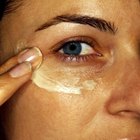
Deep cracks around the fingernails usually occur as a result of frequent exposure to soap and water, including hand-washing, bathing, cleaning house or doing dishes. Additionally, gardening without gloves, as well as exposure to wind and sunlight, are often the culprits. To treat severe cracks and prevent infection, seal the wounded areas with liquid bandage until they heal, as liquid bandage products help the cracks heal from the inside. Once the cracks are closed -- which usually takes five to 10 days -- daily care will keep the skin around your fingernails supple and pain-free. Consult your physician if the cracks around your fingernail if the cracks are red, painful or leaking pus, because they may be infected. You should also consult a physician if the cracks don't heal up within two weeks. And when you do use liquid bandage, read the packaging carefully to ensure you're following that product's specific directions.
Step 1
Wash your hands thoroughly with hand soap and water, then dry them gently with a soft towel or allow them to air-dry. Be sure the cracked areas are completely dry.
Step 2
Apply a small amount of over-the-counter liquid bandage on top of -- but not inside -- the cracks. Apply a second coat after the first coat dries, which takes about a minute. Be sure the crack is completely covered.
Step 3
Keep the cracks covered with liquid bandage until they are completely healed. Reapply the product as often as needed during that time because the plastic naturally falls off as the wound heals.
Step 4
Keep your skin well-moisturized to prevent new splits when the cracked areas heal. Use a heavy cream every time your skin is exposed to water. Massage the cream into your fingernails, with extra attention to split-prone areas such as the sides of your nails and under your nails.
Step 5
Wear cotton-lined rubber gloves whenever you wash dishes or work with household cleansers. Similarly, wear appropriate gloves when working outdoors or in the garden.
Related Articles

How to Clean a Chamois Leather Jacket ...

How to Prevent Pock Holes From ...

Help With Chapped Red Cheeks

How to Heal an Inflamed Bikini Area

How to Disinfect Sunglasses

How to Clean Scuffed Up Rain Boots

Tea Tree Oil as a Natural Remedy for ...

How to Take Care of Wrinkled Hands

How to Have Flawless Armpits

How to Repair a Fiberglass Swimming Pool

How to Clean Fake Fur

How to Glue Soles on Cheap Work Boots

The Best Facial Moisturizer That Won't ...

How to Repair Rubber Boots

How Do You Clean Barbour Jackets?

How to Polish Plastic Glasses

How to Get Rid of Irritation From ...

Will Cream of Tartar Whiten Teeth?

The Best Ways to Get Dead Skin Off of ...

How to Get Rid of a Tattoo Scab
References
Tips
- You can wash and dry your hands normally while the cracked areas are covered with liquid bandage. However, don't scrub the areas because you may loosen the adhesive.
- Although ointments help heal minor skin cracks, they should be avoided while you are using liquid bandage. The ointments may weaken the bond and delay healing.
- Wash your hands with warm water, using a gentle, fragrance-free hand soap.
Writer Bio
M.H. Dyer began her writing career as a staff writer at a community newspaper and is now a full-time commercial writer. She writes about a variety of topics, with a focus on sustainable, pesticide- and herbicide-free gardening. She is an Oregon State University Master Gardener and Master Naturalist and holds a Master of Fine Arts in creative nonfiction writing.
Photo Credits
David De Lossy/Photodisc/Getty Images